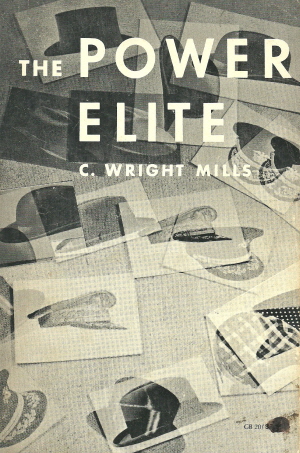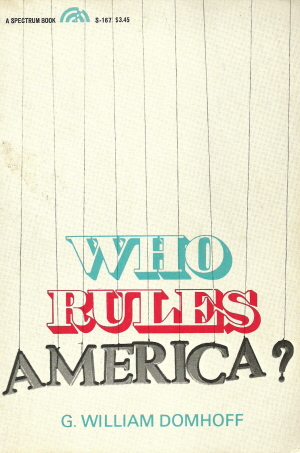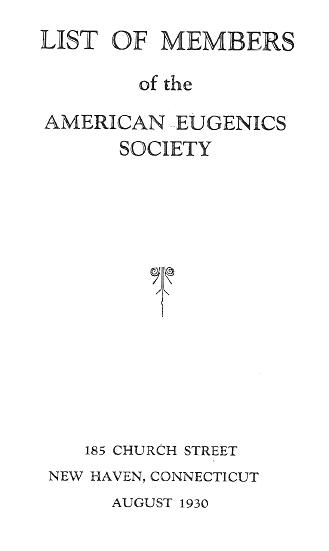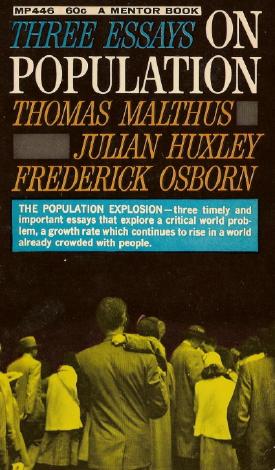 A classic analysis of the U.S. power structure This essay first appeared in Social Justice Review, November-December, 1997; rev., July, 2001. Copyright © 1997 & 2001 by Mary Meehan. Eugenics and the Power Elite Mary Meehan In her novel, Captains and the Kings, Taylor Caldwell described a world in which men of enormous wealth and power met occasionally in New York or London and discussed how they should run the world. "They were gentlemen," she wrote, "courtly and genial and of the most elaborate manners, marvelously reserved and polite and attentive, never disagreeing, never raising a voice." They were also utterly ruthless as they planned wars for profit and a world government that would reduce most people to serfdom. And they were succeeding on every front, moving the world toward: "Benevolent despotism accompanied by an entertaining show of elections and plebiscites--which meant nothing at all."(1) Today, when we see so much evil around us--and when so much of it seems premeditated by "courtly and genial" gentlemen--it is tempting to believe Caldwell's scenario. Yet the world is more complicated than that. The Caldwell approach seems to have enough truth to explain some things, but enough exaggeration to lead to paranoia and despair. On the other hand, those who accept the civics-class approach that we learned in junior high school, in which the people truly run the country, are caught in great naiveté. They constantly spin wheels, flail arms, and wonder why they make so little progress as they try to change the world for the better. Is there a middle road that avoids paranoia and despair, on the one hand, and pathetic naiveté on the other? I believe there is, and that it can be found in the concept of the "power elite" as described by the late sociologist, C. Wright Mills, and refined by G. William Domhoff of the University of California, Santa Cruz. Relying mainly on Domhoff [specifically, on the 1967 edition of his Who Rules America?], I will describe who the U.S. power elite are and how they operate and then suggest how eugenics works through them.  Domhoff focuses primarily on the U.S. power structure, and I will do the same, while noting that it would be helpful to have more research and writing on the international power structure. There, too, caution is needed: The Trilateral Commission and the Bilderberg group do not by themselves run the world, although it would be unwise to ignore them. In Domhoff's view, the American upper class perpetuates its wealth and rears its children through private schools and private clubs, the Ivy League and other celebrated universities, the great private foundations, powerful media outlets, and prestigious groups such as the Council on Foreign Relations. The upper class recruits and assimilates talented young people from the lower classes, sometimes rewarding their service with foundation or university presidencies. Such recruits, whether or not they become full-fledged social members of the upper class, are members of the "power elite." So are those members of the upper class who choose to be and are willing to work. As Domhoff notes: "Contrary to the stereotypes, most members of the American upper class are and always have been hard-working people, even at the richest levels." The Rockefellers are excellent examples of this. While the upper class is united in wanting to keep its wealth, it does not agree on everything. Domhoff has no doubt that "there are contending cliques" within the upper class, though he also notes that the cliques do not always contend; sometimes, he says, they "merely divide the labor."(2) And, one might add, the spoils. Occasionally, though, there is a major split within the upper class, such as the one caused by the New Deal. Part of the upper class, Domhoff believes, accepted the New Deal as a stabilizing force that ultimately would save their wealth, while another part doggedly resisted it as an attack on their wealth. In this Domhoff follows C. Wright Mills, who said that the first group, the "business liberals," are "more flexible in adjusting to such political facts of life as the New Deal and big labor" and "have taken over and used the dominant liberal rhetoric for their own purposes." The Mills point about adoption of liberal rhetoric is important in discussion of motivation, especially when we think about his remark that "most American men of affairs have learned well the rhetoric of public relations, in some cases even to the point of using it when they are alone, and thus coming to believe it."(3) The "business liberals" are internationalists who are eager to use the power of the U.S. government to advance their business interests abroad. The Council of Foreign Relations and the U.S. State Department are two of their favorite instruments. Mills, Domhoff, and others have offered overwhelming evidence about the power elite, not contending that they control everything but, rather, that they have enormous power and influence. From my own reading of recent American history, I would suggest that their power is so great that the American people have, at best, a braking influence on policies they especially dislike. In certain rare circumstances such as the late years of the Vietnam War, they may even have a veto power or an "end-it" power. Even in cases of great popular resistance to policies such as those involving Vietnam and abortion, though, the manipulative and coercive powers of government are so great that it generally takes years to obtain even small or cosmetic changes in policy. "We the people," so flattered by our rulers when they want our votes, have very little real power. Yet there is much potential power in our traditions, our institutions and our collective money. If we choose to do so, we can have real power. How does eugenics relate to the power elite and to the government they largely control? Mills and Domhoff have not, so far as I know, applied their analysis of the power elite to eugenics. While acknowledging my great debt to them, I want to make it clear that they are in no way responsible for what follows. The upper class has supported the movement to breed a better human race for more than 80 years, with both its brain power and its money. Wherever possible, however, it has used money taken from taxpayers and spent by the U.S. government. This has given a government seal of approval to population control, including sterilization and abortion, and has institutionalized it for the poor. Public funding has also institutionalized the practice of genetic counseling and eugenic abortion for all classes. Finally, it has saved the wealthy from paying so much from their own pockets for their many projects to improve the human race. Their attitude reminds me of the scene in The Last Hurrah in which Mayor Frank Skeffington suggested why his arch-enemy, the wealthy and bigoted publisher Amos Force, quit the Ku Klux Klan. "I always suspected," Skeffington said, "it was because he found out he was expected to buy his own sheet."(4) Less stingy than Mr. Force, wealthy families of the old "robber barons" financially supported eugenics in the early years of this century. Mrs. E. H. Harriman, widow of the railroad king, was an early supporter of eugenics; so was the Rockefeller Foundation at the direction of the senior John D. Rockefeller, the oil baron. A whole flock of Rockefeller foundations, as well as individual family members, eventually gave huge sums to eugenics projects.(5) The 1930 membership list of the American Eugenics Society included Vincent Astor, Bernard Baruch, George Eastman, Thomas Lamont, John D. Rockefeller, John D. Rockefeller, Jr., and Margaret Sanger.(6)  Sanger, viewed by her left-wing admirers as a radical, in fact moved in upper-class circles after she married a rich businessman and started raising money from other wealthy people, including the Rockefellers. Her American Birth Control League, later merged with another group and renamed the Planned Parenthood Federation of America, had many other eugenicists among its supporters. Today wealthy families still send money to Planned Parenthood almost automatically; this seems to be on a par with their country-club dues. Many, probably most, Planned Parenthood volunteers today are not conscious eugenicists. But they do not have to be in order to play their part in the great scheme of things. Planned Parenthood and several other organizations are like wind-up toys that eugenicists started in the 1930s and that still march, relentlessly, along their appointed route. Far more important than Margaret Sanger was Frederick Osborn (1889-1981), the grand strategist of the American Eugenics Society from the 1930s to the early 1970s. Although virtually unknown to the American public, Osborn was one of the most influential men of his generation. He was from a wealthy New York family and made his own fortune in business as a relatively young man. Developing a working knowledge of demography and genetics, he spent the rest of his long life in the quiet but extremely effective promotion of eugenics. Osborn was a friend of the Rockefellers and the Franklin Roosevelts; a trustee of the Carnegie Corporation of New York and of Princeton University; a founder of the Population Association of America and the American Society of Human Genetics; and a founder and the first administrator of a key Rockefeller enterprise, the Population Council. He was both brilliant and very patient. A disciple of Francis Galton, the founder of modern eugenics, Osborn understood Galton's remark that it is possible to make a huge steamship "change her course slowly and gently by a slight turn of the helm" and that the ship may even be turned completely around "without attracting the notice of the passengers."(7) Osborn used private-foundation money and establishment institutions in slowly and carefully turning the United States in a eugenic direction. He also made maximum use of the social sciences, especially fertility surveys and public opinion surveys, in calculating how the public could be manipulated. After World War II and the discrediting of the Nazi version of eugenics, Osborn managed to convince many people that he had started a "reform eugenics" that--unlike the earlier version--was not racist. This enabled him to recruit for the board of the American Eugenics Society prestigious scientists such as Theodosius Dobzhansky and Richard Lewontin. Well into the 1950's, however, Osborn was associated with Wickliffe Draper, an eccentric Harvard graduate so bigoted that he wanted to send black Americans back to Africa. Draper financed, and Osborn led for years, a eugenics foundation called the Pioneer Fund. The Pioneer Fund still exists; it has financed the work of Arthur Jensen, who claims that blacks are genetically inferior to whites in intelligence, and it has helped support anti-immigration groups such as FAIR (Federation for American Immigration Reform).(8) Although it has its own special uses, the Pioneer Fund is very small when measured against the Rockefeller, Ford, Mellon and other large foundations. The great foundations give cascades and torrents of money to the cause of population control. Frederick Osborn, with his key contacts in the upper class, did much to start this flood of money. Osborn was instrumental in starting Princeton University's Office of Population Research in the 1930s. There his friend and fellow eugenicist, Frank Notestein, worked for many years and helped Osborn develop plans for population control in poor nations. During World War II, Notestein took part in secret planning for the post-war era that was financed by the Rockefeller Foundation and run by the Council on Foreign Relations for the U.S. State Department. This project, which designed U.S. foreign policy of the post-war era, was one of the most successful ventures of the "business liberals." Notestein wrote a paper for the project, suggesting massive manipulation of poor nations then emerging from colonialism so they could modernize their economies and slow their population growth. Later he worked on population matters for the United Nations; later still, he was president of the Rockefellers' Population Council.(9)  Eugenics, of course, is not the only driving force behind population control. Also important is the national-security motivation. This is based on the belief that rapid population growth in poor nations leads to political instability that threatens U.S. foreign-policy interests, including access to natural resources in the Third World. During the Cold War, there was also enormous concern that instability would lead to Communist take-overs. Leading population controllers such as William H. Draper, Jr., Hugh Moore, and their colleagues in the Population Crisis Committee (now Population Action International) and the U.S. State Department stressed the national-security rationale.(10) But this does not really conflict with the eugenics approach; instead, it reinforces it. Holders of either or both views want the industrial West to dominate the world. They view poor people, especially the desperately poor, as troublesome surplus. They view the middle class as tolerable, so long as it doesn't have too many children. During the drive for population control in the Nixon administration, a White House aide referred to "the extraordinary fecundity of the American middle class--in light of its 'allotted' 2.1 children per couple." According to Daniel Patrick Moynihan, who was then Nixon's population planner, John D. Rockefeller 3rd "assured me that" population controllers generally agreed "that in the United States, at all events, it is the wanted children who are going to cause the problem."(11) The eugenicists and the power elite apparently want to have a controlled world in which people range from middle-class to wealthy, with everyone a good producer and a big consumer, so the world economy will keep humming along. With no surprises and no untidiness. They are the ultimate control freaks. Given their enormous power, is effective resistance to their "benevolent despotism" even possible? I believe that it is, and that it lies partly in two things they really understand and care about: public relations and money. Exposing the ways the powerful have manipulated us can go a long way toward upsetting their public-relations applecart. This should include detailed explanations, with archival documentation, of how the disabled, people of color, poor people, women, teenagers, and Third World people have been targeted and harmed. There should also be efforts to use the very real economic power of "little people" against institutions that promote eugenics. Economic boycotts can be quite successful. In an age when stockholding is so widespread, shareholder resolutions can have real impact on corporate policies. The government, of course, is another kettle of fish. Tax resistance is difficult to organize, but there are many directly political routes to ending government support of eugenics. A strategy of full-scale exposure, especially if done eventually in congressional hearings, could be a giant step toward defunding. Without the money and the coercive power of the state, eugenics would lose much of its drive. Notes 1. Taylor Caldwell, Captains and the Kings (Garden City, N.Y., 1972), 251 & 522. 2. G. William Domhoff, Who Rules America? (Englewood Cliffs, N.J., 1967), 31 & 142. [The book has gone through many editions since 1967.] 3. C. Wright Mills, The Power Elite (New York, 1981 reprint), 122 & 5. 4. Edwin O'Connor, The Last Hurrah (Boston, 1956), 155. 5. See many valuable collections at the Rockefeller Archive Center, Sleepy Hollow, N.Y. 6. Margaret Sanger Papers, microfilm, reel 41, Library of Congress, Washington, D.C. 7. Francis Galton, Inquiries into Human Faculty and Its Development (London, 1883), 317. 8. Frederick Henry Osborn Papers and American Eugenics Society Archives at the American Philosophical Society Library, Philadelphia, Pa. For more information on Wickliffe Draper and the Pioneer Fund, see Harry H. Laughlin Papers, Northeast Missouri State University, Kirksville, Mo.; and Pioneer Fund tax returns, Foundation Center Historical Foundation Collection, Special Collections and Archives, Indiana University-Purdue University Indianapolis (IUPUI) University Library, Indianapolis, Ind. 9. Frank W. Notestein Papers, Seeley G. Mudd Library, Princeton University, Princeton, N.J.; and Council on Foreign Relations, Studies of the American Interests in the War and the Peace (New York, 21 April 1944, No. T - B 72). 10. Hugh Moore Fund Collection, Seeley G. Mudd Library, Princeton University, Princeton, N.J.; and Record Group 59 (State Dept.), Central Foreign Policy Files, 1967-69, National Archives, Archives II, College Park, Md. 11. Checker Finn, Memorandum for Dr. Moynihan, 7 Aug. 1969, in Nixon materials, White House Central Files/Subject Files: Welfare (WE) Box 29, National Archives, Archives II, College Park, Md.; and Daniel P. Moynihan, Memorandum for Honorable Arthur F. Burns, 18 June 1969, in Nixon materials, White House Central Files/Subject Files: EX FG 275 (Commission on Population Growth and the American Future), Box 1, National Archives, Archives II, College Park, Md. |